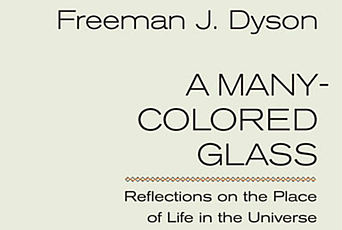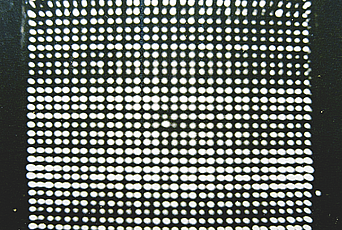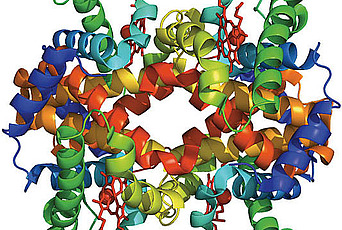The Tavern and the Meeting House
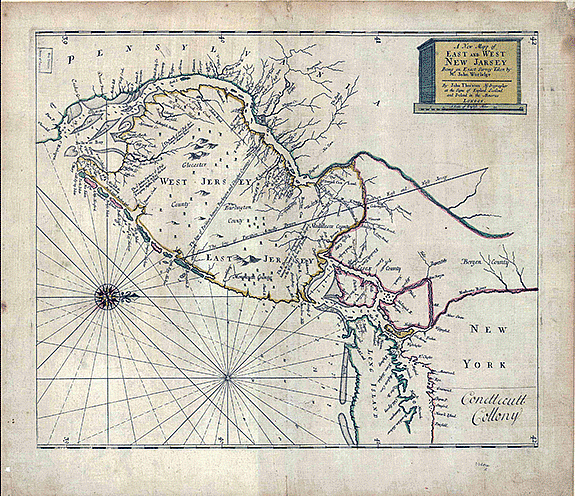
It was the Lenni Lenape! It was the tribes of the Lenni Lenape! The sun rose from water that was salt, and set in water that was sweet, and never hid himself from their eyes . . . It was but yesterday that the children of the Lenape were masters of the world. — James Fenimore Cooper, The Last of the Mohicans
New Jersey’s original inhabitants, the Lenni Lenape (“Men of Men”) abandoned the interior in summer and headed either to the Jersey shores or to encampments on the estuaries of Delaware Bay. “From June to this present month, August,” reported William Penn (1644–1718) during his first summer on the Delaware in 1683, “we have had extraordinary heats.”
Penn landed in Delaware Bay on October 27, 1682, after a passage (from Deal, England) of fifty-nine days aboard the Welcome during which smallpox broke out and thirty-one of his ninety-nine fellow colonists died. Penn, who had survived smallpox at the age of three, ministered to the sick during the voyage and arrived in excellent health. The Lenape met the newcomers with diplomacy, but the colonists had technology and immunity on their side. “What is the matter with us Indians,” Chief Tenoughan, of the Schuykill River, asked William Penn, “that we are thus sick in our own Air, and these Strangers well?”
Following his Restoration in 1660, Charles II of England had challenged the Dutch claims to North America, granting the entire territory between Virginia and New France to his brother, the Duke of York (later James II), in 1664. The territory was named New York, and a portion of it, between the Delaware and Hudson rivers, was named New Jersey, with the west half (bordering the Delaware River and Delaware Bay) assigned to Lord Berkeley and the east half (bordering the Hudson River and the Atlantic Ocean) assigned to Sir John Carteret.
In 1675, Lord Berkeley sold his interest in West New Jersey for £1,000 to John Fenwick and Edward Byllynge, two Quakers whose subsequent dispute over the property was referred for arbitration to William Penn. Fenwick sailed for America, while Byllynge fell into debt and eventually transferred his interest to a group of creditors including Penn, who also purchased an interest in East New Jersey (including much of what would become Princeton) at auction in 1682 for £3,400 from Carteret’s estate.
William Penn was the rebellious son of Admiral Sir William Penn (1621–70), who led the English fleet in two wars against the Dutch and captured Jamaica for Cromwell in 1655. Sent to Oxford at age fifteen and soon expelled, the younger Penn took up with the Quakers, a nonconformist sect, and was imprisoned seven times. Admiral Penn died in 1670, leaving his son to manage his estate, including £16,000 owed to it by the Crown. Officially £11,000 in “victualling expenses,” plus interest, rumors lingered that the admiral had covered the king for a gambling debt.
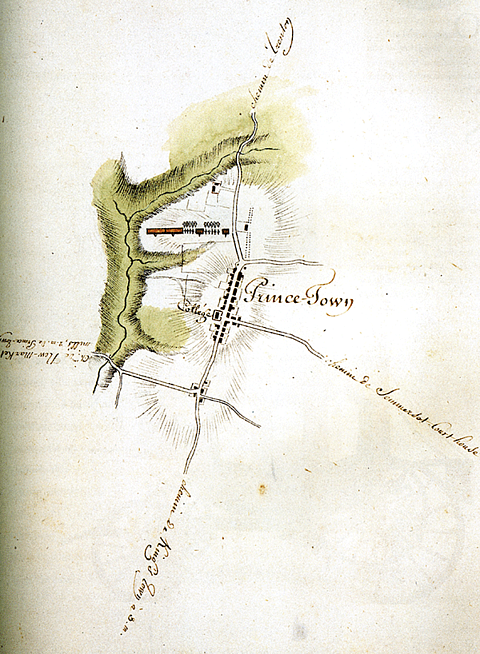
Penn petitioned the king, in 1680, for a settlement of this debt, proposing the Crown grant him “a tract of land in America, lying north of Maryland, on the east bounded with Delaware River, on the west, limited as Maryland is, and northward to extend as far as plantable, which is altogether Indian.” Charles and James said yes—resolving the debt, and exporting one of the ringleaders of a troublesome religious sect. The colony of Pennsylvania, with its capital Philadelphia, was the result.
To the west of Pennsylvania lay open wilderness, while to the east the wilds of New Jersey began to be squeezed between two growing populations centered upon Philadelphia and New York. The most direct connection between the two settlements was overland across the “waist” of New Jersey, between the head of navigation on the Delaware River (near present-day Trenton, upstream from Philadelphia) and the head of navigation on the Raritan River (near present-day New Brunswick, upstream from New York). This well-worn Lenni Lenape footpath became, in succession, a trail passable by horses, a wagon road, the “King’s Highway” for stagecoaches, and finally State Routes 27 and 206.
In 1683, a settler named Henry Greenland opened a tavern near the midpoint of the wagon road, and around this nucleus the village of Prince-Town began to form. The proprietors of East and West New Jersey met at Greenland’s Tavern in 1683 to decide their common boundary (marked by the present-day Province Line Road) and thus put Princeton on the map. The Nassau Tavern (and Nassau Inn), successor to Greenland’s Tavern, is still where coaches drop off travelers and Princeton University houses its guests.
Meanwhile, a small group of Quakers were seeking to distance themselves as far as possible from the increasingly secular influences of Philadelphia and New York. Halfway between the Raritan and the Delaware, and slightly to the south of the overland trail, was a small stream named Wapowog by the Lenape, flowing through land that was taken up in 1693, as his share of the original grant to the proprietors of East New Jersey, by William Penn. Six close-knit Quaker families, with Penn as an absentee partner, founded a colony here in 1696, and named it Stony Brook. Instead of a tavern, they built a Quaker Meeting House, where Friends congregate, at the edge of the Institute Woods, to this day.
The patriarchs of these families were Benjamin Clarke, William Olden, Joseph Worth, John Hornor, Richard Stockton, and Benjamin Fitz Randolph, with Stockton becoming the largest landowner thanks to 5,500 acres purchased for £900 in 1701 from William Penn (who reserved 1,050 acres “as to said William Penn shall seem meet and convenient” for himself). Benjamin Clarke purchased 1,200 acres between Stony Brook, the Province Line, the present Stockton Street, and the present Springdale Road, in 1696, conveying 400 acres (including the site of the Institute for Advanced Study) to his brother-in-law, William Olden, and deeding 9.6 acres in trust for the Quaker Meeting House and Cemetery in 1709.
When the College of New Jersey (established by Presbyterians) was moved from Newark to Princeton in 1752, John Stockton and John Horner, who put up a £1,000 bond and provided 10 acres of cleared land and 200 acres of woods, were careful to site the future University near the tavern, on the main road. When Abraham Flexner, Oswald Veblen, and the Bambergers selected a location for the Institute, they chose Olden Farm, near the meeting house on Stony Brook.
It took more than five years for the founders to reach agreement—not only on a specific site, but on whether the Institute should purchase land or not. “The way to reform higher education in the United States is to pay generous salaries and then use any sort of makeshift in the way of buildings,” argued Flexner in 1932.1 Four years later, after conceding to the purchase of Olden Farm, Flexner was still complaining to Veblen that “I would far rather rent additional floor space in 20 Nassau Street and get our minds so full of the purposes for which we exist that we will all become relatively indifferent to buildings and grounds.”2
Louis Bamberger, although approving the purchase, admitted to Flexner that “some of our coworkers in the management of the Institute were inclined to rush along with more haste than wisdom,” and noted that “Mrs. Fuld has repeatedly commented on a policy of acquiring so much land for an institution that proclaimed not size but highest standards.”3 Flexner, in return, warned the Bambergers, via their legal counsel and founding Trustee Herbert Maass, that Veblen “is a most excellent person, but the word ‘building’ or ‘farm’ has an intoxicating effect upon him.” 4
Veblen, an avid outdoorsman who, after winning one prize in sharpshooting and another prize in math, had taken time off from his undergraduate studies to travel down the Iowa and Mississippi rivers in the style of Huckleberry Finn, found the combination of the Bamberger fortune and the depressed land prices of the 1930s a potent mix. “There is no educational institution in the United States which has not in the beginning made the mistake of acquiring too little rather than too much land,” he wrote to Flexner, urging the acquisition of “a sufficiently large plot of land, which would thus be kept free from objectionable intruders.” 5
The latter argument had the desired effect. “I have it in mind now to go down to Princeton quietly for a week or so for the purpose of familiarizing myself with the general situation, for that may help us in our final choice,” Flexner reported in October 1932. “I should like to be away from undergraduate activities and close to graduate activities.” 6
There was no turning back, once word leaked out that the Institute was looking for a home. “The fact that we propose to locate in the vicinity of Princeton is now a matter of public knowledge to such an extent that, I believe, we are being made the victim of a distinct firming up in prices, and that we had better attempt to come to an early decision,” Maass advised Flexner in November 1932.7
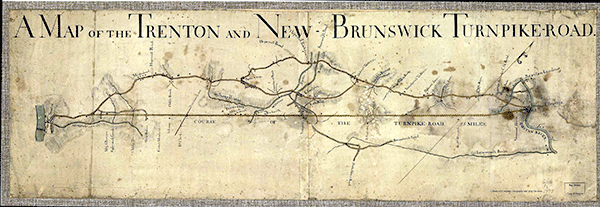
Veblen jumped at the chance. “If we are going to have inflation, would it not be well to speed up the land question?” he argued. “At least two of the proposed sites seem good to me.”8 By 1936 some 256 acres had been purchased for a total of $290,000.9 The acquisitions included the 200-acre Olden Farm, purchased after lengthy negotiations for $175,000. This included Olden Manor—the former William Olden house and now the Director’s residence—as well as a cluster of farm workers’ houses at the end of Olden Lane, and a large, working barn.
“I am, as you and Mrs. Fuld are, very glad that we have acquired a site, though I think it would be prudent for the present to keep the matter quiet,” Flexner wrote to Bamberger in October 1935. “Though I do not wish to criticize either Mr. Maass or Professor Veblen, I think there is some danger that they will both be too enthusiastic about the acquisition of additional land.”10 The Bambergers responded, as Maass reported to Flexner in December, by “[playing] Santa Claus by paying for the land.” 11
Veblen was not to be constrained. Over the next few years, he drove a series of bargains with depression-strapped landowners to extend the Institute’s holdings to a total of 610 acres, including the Institute Woods. “I have walked over the new property of the Institute several times since there has been a hard crust on top of the snow,” he reported in early 1936. “This enables one to explore the woods down near the brook much better than one will be able to after the ground gets soft again.” 12
Among the properties acquired was the Maxwell estate, to the west of Olden Farm, extending from Mercer Street toward Stony Brook. “The Maxwell House is a composite,” noted the Committee on Buildings and Grounds. “The front of the house was the front of old St. George’s Hall which stood at 13th and Arch Streets, Philadelphia. The Corinthian columns in the halls came from a row of houses built by John Jacob Astor at Broadway and 11th Street, New York. The Italian marble mantel in the drawing room came from the home of A. T. Stewart, and the carved wooden mantel in the library from the dining room of J. P. Morgan, the chandelier from a chateau in France, etc. The pipe organ was installed in 1914.” 13
The purchase of the remainder of the Maxwell estate (complicated, as it remains today, by its status as a historic battlefield) was concluded by Frank Aydelotte, Flexner’s successor, in 1945. “I think this is the psychological moment to close the deal,” Aydelotte reported to Maass in September 1945. “With this tract in our possession, the Institute will have one of the finest pieces of educational real estate that I know of anywhere.” 14
Aydelotte was right. The Institute’s holdings now extended from the Graduate College to the Quaker Meeting House on Stony Brook, and included not only these fields and woodlands, but their Quaker legacy, and a direct link to the original inhabitants, via William Penn. “I find them . . . of a deep natural sagacity,” Penn wrote to his friend Robert Boyle of the Royal Society, after his first tour of the Lenni Lenape country in 1683. “The low dispensation of the poor Indian out shines the lives of those Christians, that pretend an higher.”
While still in England, Penn had drafted a constitution for the new colony, issued in 1676 as the “Concessions and Agreements of the Proprietors, Freeholders, and Inhabitants of the Province of West New Jersey.” Exactly one hundred years before the Declaration of Independence, this document established a representative democracy with freedom of religion and assembly, trial by jury, economic liberty, and other principles that would later be incorporated into the Constitution of the United States. Richard Stockton and John Witherspoon, both children of the Stony Brook settlement, were signers of the Declaration of Independence, and following the Revolutionary War the Continental Congress met from June to November 1783 in Princeton at Nassau Hall. On October 8, a delegation representing five hundred Quakers appeared before Congress in Princeton, “soliciting the Christian interposition of Congress, for the discouragement and prevention of the slave trade.”
While negotiations for the purchase of Olden Farm were underway, the Bambergers expressed their hope that the Institute’s School of Economics and Politics would “contribute not only to a knowledge of these subjects but ultimately to the cause of social justice which we have deeply at heart.” 15
This objective, as well as its physical location, the Institute owes to William Penn.
The following materials in the Institute’s Shelby White and Leon Levy Archives Center were consulted in the writing of this article:
1 Flexner to Bamberger, December 1, 1932
2 Flexner to Veblen, January 6, 1937
3 Bamberger to Flexner, October 29, 1935
4 Flexner to Maass, December 15, 1937
5 Veblen to Flexner, April 12, 1934
6 Flexner to Maass, October 18, 1932
7 Maass to Flexner, November 9, 1932
8 Veblen to Flexner, March 13, 1933
9 Maass, Trustees’ Minutes, April 13, 1936
10 Flexner to Bamberger, October 28, 1935
11 Flexner to Bamberger, December 19, 1935
12 Veblen to Aydelotte, February 13, 1936
13 Conversation on the Maxwell Property, September 16 and 17, 1940 (Beatrice Stern files, Buildings and Grounds)
14 Frank Aydelotte, Memorandum for Herbert H. Maass, September 7, 1945
15 Louis Bamberger to the Trustees, April 23, 1934
